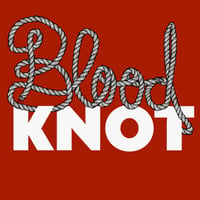“The Double Overhand Knot is called a Blood Knot when used on a cat-o’-nine-tails, or on the snapper of an ox whip.”
The Ashley Book of Knots
It is also a very beautiful knot in its perfect simplicity and symmetry. For those who may shy away from its brutal history, it was also the knot used by monks to weigh down the spartan lengths of rope with which they tied their cassocks. My Grandfather taught me to tie a bloodknot when he took me fishing as a young boy.
My interest in knots was born in about 1983 when I was a young seaman aboard HMAS Hobart (DDG39). I was in the after mess where 81 men lived. I saw two old Vietnam veteran Leading Seaman tying Turks heads on something. I thought the Turks heads looked amazing and they taught me how to tie both the Turks heads and some French Hitching on my brand new sailors knife, or boom knife as we called them. From there I went on to make my own tool belt (gun belt) which held our knife, marlin spike and other tools necessary for a seaman working on the upper decks. My gun belt was made using square knotting and it survived the next nine years at sea. I still have it, but it must have shrunk and no longer fits.
After leaving the Royal Australian Navy and starting my grown up life, I only dabbled in knotting intermittently when time and inclination permitted. However in the last few years with the advent of social media and exposure to Mikko Snellman, Phillip Le Masurier, John Trevvett and several others, my interest was renewed. One thing led to another and here I am knotting and making cordage.
For knots to be seen at their best they should be tied in what’s called hard laid cord. The hardness of the cord allows the knots to hold their form. Once you’ve gone ‘hard lay’ it’s hard to go back. Sadly the legendary Belfast Cords, the last commercial manufacturer of quality hard laid cord, went out of business many years ago. There are some dedicated artisans, some of whom I've mentioned,who have filled the void and custom make beautiful hard laid cord. These artisans sparked my curiosity, which in turn led to hours of research and experimentation. Eventually, I designed a working cord twister. A year or so later Philip Le Masurier offered me his set up. My twister was better than his but his drive system was far better than mine, as was the design of his rope walk. I transported Philips gear home in an almost 2000 kilometre round trip in an epic 22 hour drive. I modified both systems and I have started to produce cord I can be proud of.
This site is mostly here to help me share my cord around but I may occasionally include some of my knotted pieces for sale as I make them.
If you have ideas you’d like me to help you with, or any specific products you'd like me to produce, please drop me a line. I may not be an expert but I'll do my best to help.
Mark Delaforce
